In the misty reaches of the prehistoric past—in the days
before the fall of the great lizards—there lived a creature,
the likes of which the world had never seen. In his time, he strode
through the Valley of Flame like a giant, red-scaled demon—his
only companion, a young Dawn-man called Moon-Boy... |
ANCIENT'S EVENING -- Jack Kirby's DEVIL DINOSAURby & © 1997 DDD #10Some folks think "evening" means nothing but "night". In fact, though, it's the time between daylight and no-light, the hours in which the sun meets the moon -- a time to herald the end of light and the beginning of the long night to come. You could also say "it's an even-ing time," when the score is evened and a balance is struck. Whatever you say, all of these, to me, define Jack Kirby's finale to the Marvel Age of Comics: DEVIL DINOSAUR.WHEN THE SUN MEETS THE MOONThe Devil Dinosaur stories can be read together, on a more superficial level, as simply an adventure. He's constantly accompanied by a young prehistoric lad called "Moon-Boy" so you could also see these, more-precisely, as Lassie-like tales of a boy and his dinosaur. Or, if Devil is something of a super-heroic "Captain Pre-Cambrian" then Moon-Boy might be seen as his faithful friend and mascot.Moon-Boy has his own idea, of course. He describes their relationship, in DEVIL DINOSAUR #1, as merely one of convenience -- "There is safety in (Devil's) shadow -- and food where he trods." It was, of course, a much stronger bond than that statement would imply. It was really a friendship forged by mutual acts of kindness. In his admiration of young Devil's fight against the Killer-Folk, Moon-Boy offered to help, and Devil, in turn, despite his injuries, fought off a Leaper who tried to take a Moon-Boy snack. During their subsequent escape the two soon found a new way of travelling that would keep them together -- Moon-Boy on Devil's back -- but would also forever set Moon-Boy apart from his own people, the Small-Folk, who fear the terrible creature he calls "friend". So with Devil an orphan and Moon-Boy an outcast, the two set-off to survive on their own in the dangerous prehistoric wilds of their homeland, the Valley. This perilous place, not found on any map or timeline, offered an amazing number (for anyone but Kirby) of strange and perilous possibilities for exploration. Alongside the physical dangers lurked the psychological perils for, as in the other pure Kirby works like the Fourth World books, there's an intriguing number of subtextual patterns simmering beneath the flying fists and pterodactyls. It may be equally perilous to read too much into these things, but it's awfully tempting to look at Devil and Moon-Boy as Yang and Yin, the Sun and the Moon.
Likewise, Moon-Boy can be seen as the other philosophical-half of the Brain, the Moon-mode, the Yin. He's not only dark in coloring, but in the first issue it's explained: "Unlike most others of the Small-Folk Moon-Boy feels no terror at night-fall. It is a time when the heavens sparkle -- when the moon casts its mysterious light. The night gave Moon-Boy his name..." In fact it was the lure of the night which leads him to meet Devil in the first place. As he remembered in the first issue: "The Small-Folk were asleep in their dark caves when I left to follow the night-trails. There was danger, but I was eager to see the fire-mountain." He's full of great emotion: sadness and happiness, excitement and fear. In DEVIL DINOSAUR #4 we see the balance between the two most-clearly defined. Moon-Boy dreamt a terrifying vision (the vividness of which is yet another aspect of the Moon-side) of the legendary Leviathan which will come to swallow the moon. When the Sky-Demons appear to fulfill this prophecy, Devil's first inclination is to aggressively react. Moon-Boy's first thought is fearful retreat. It's no wonder that one feels lost without the other. They're necessary to each other's existence. Speaking of which: it's been said before that Devil Dinosaur has represented Kirby himself, his feelings as an outmoded creature in the industry he, in many ways, helped to survive. Well, if that's the case -- and we can see Kirby as the aggressive Yang-side of the brain -- I wonder how much we can look at the relationship of Devil and Moon-Boy in the light of what we know of the partnership between Kirby and Lee and/or Kirby and Simon, with Lee & Simon in the role of Moon-Boy? WHEN THE SCORE IS EVENEDIt's possible, due to his voracious reading, that Kirby was familiar with the left-brain/right-brain concept. Even then it's unlikely he planned this out, though it could be explained by his instinctual style of story-telling which often brought many wonderful concepts from the unconscious. Also, Kirby was one for balance.Take a look, for example, at the supporting players of his four-part Sky-Demons saga (DEVIL DINOSAUR #s 4, 5, 6, 7). The Old One, Stone-Hand and Eev are not just "good" or "evil". The Old One is the first to trust the help of Devil in the fight against the Sky-Demons. But he's also the first to succumb to the easy life of the Demon Tree. Stone-Hand reluctantly agrees to follow Devil in the battle, and continues to distrust our-favorite dinosaur throughout his time on stage, but he's also the first to fight against the Demon Tree. Eev doesn't trust Devil, either. But she also doesn't trust the Old One or Stone-Hand. She's only looking out for herself. Then again, she's also the one to show compassion for the Old One. And these are just some smaller points to their extremely well-balanced and multi-faceted characters. Back to the main 'players'... While it's easy to speculate Devil into a representation of Kirby's feelings on working in the contemporary comic book scene, that he was a dinosaur lost in time, the theory belies the point Kirby continues to come back to in this book: Devil and Moon-Boy are a true pair, connected to each other in mysterious ways. So I'd prefer to look at the two together, as a whole, because it's there you see a clearer picture of Kirby the man and artist. On the one side he's Moonboy, a continual questioner, restlessly seeking out the truth even when it takes him places that his own kind would not want to go. The constant impetus is the question "What if?" On the other side he's Devil, an unhesitating defender of the weak and helpless. He doesn't pick a fight, but when he or others are attacked, look out! He'll tenaciously attack the page with his pencil until all questions are answered. Kirby's idea of exercise afterall, was "thinking", using his brain.
It's no wonder that so many of his super-characters, despite their predilection
for leaping and punching, also exhibited unusual brain-traits: Silver
Star, Captain Victory, the Project's creations, Lancelot Strong, etc.
Here too is another possible link between Devil Dinosaur and Moon-Boy.
The Sky-Demons initial examination of Moon-Boy in issue #5
shows "a greater potential for intelligence!" than the others they've
investigated. The picture of Moon-Boy's brain scan reminds me of when
the Guardian is examined in Kirby's Jimmy Olsen series (issue #139)
and Tommy's dad remarks "Except for some strange unidentifiable activity
in the brain area -- he seems ready --" The aliens also note Devil's vanquishing some of their own "with calculation as well as might!" which leads them to speculate that perhaps his brain may also register a similar reading to Moon-Boy's. Kirby may've wanted to come back to this later in the series but, of course, we'll never know. I especially like the idea that Devil Dinosaur and Moon-Boy are, together, a "whole" because Kirby didn't appear to believe in the need for divisions of any kind, let alone in the mind. As he said in an interview with Ken Viola in February 1987 (reprinted in 'The Collected Jack Kirby Collector, Volume 1", p. 134): "All the next guy wants to say is, 'Here I am. You don't have to tell me what to do, I'll do it my own way. But how about you and I? What should we do together on this world?' I think we've always been trying to say that through the ages, even through all that isolation from each other. We all live together on the same planet. It's not a map to me, it's a world. People believe that the world is marked by borders, but to me, it's not. Because if we don't take a direction different from that, we're in trouble." Devil Dinosaur and Moon-Boy are the "you and I" and they represent a fine example of what we can do together in this world. As different as they are from each other, they're sensed as even more different from their own kind. The battling tribes of Small-Folk, Hill-Folk, Forest-Folk, Killer-Folk and Dino-Riders only recognize their own maps, constantly in a state of staking out what they feel is "their" territory. Perhaps that's why Kirby gave us the multi-part alien invader story and all its consequences. The Sky-Demons, like Devil Dinosaur and Moon-Boy, recognized the planet as a world, rather than a map. But they represented the dark side of this recognition because they didn't care about the territorial battles for individual pieces of terra, they wanted the whole thing -- despite the consequences to the beings already there. Like the battling tribes, it didn't matter who was there first. This disregard for the pioneers could also bring up another comparison. At the time of DEVIL DINOSAUR's publication there was a great disregard for the pioneers of the comic book industry. Many of the other Marvel editors of the time were busy staking claim to territory that Kirby first mapped. While they squabbled, though, he was off on other-paths of his own choosing and devising. To me, his consistent steering away from the path of what-was-expected revealed to him a wider sight of all things, as Devil and Moon-Boy's alienation allowed them a broader world-view than that seen by the other tribes and creatures. What he probably didn't see, was that this path would take him too close to a nest of vipers. THE END OF LIGHT: "And thus endeth the chronicle ...""And here he was drawing Devil Dinosaur, being hooted at by the fans, taking crap from assistant editors who would never create anything in their lives, seeing his original art being sold at conventions, collecting his page rates. It was time to go...In 1979, for the first time in forty years, there was no Jack Kirby in comics. No one even seemed to notice."This was Kirby's situation then, as described by Gerard Jones and Will Jacobs in their book, "The Comic Book Heroes" (1997, p. 228). The company line of the time said that Kirby was going to work on the animated-versions of his Marvel characters, that he'd be too busy to continue to create Marvel comic books. The fact of the matter was that Kirby never created Marvel comic books. He was creating Kirby comics, no matter what the company cover indicia said. It was twilight for one of the few real gods in the comic book industry -- he'd never create anything new for any major company again. Kirby was at the very least co-creator of the comic book industry but, despite that, he didn't have any control over the monster it had become. Like the gods of whom he told many many tales, Kirby was literally devoured by his own creation and progeny. Just like the gods of whom he drew, though, Kirby went out with his head held high. He was going to go out with dignity, class and a helluva fight. DEVIL DINOSAUR, can also, then, not only represent that fight, but everything Jack Kirby stood for. The company-line carried an ugly subtext, one echoed in the popular fan press of the time. It said, truthfully (though that wasn't its aim), Kirby's work didn't fit in with the rest of the Marvel Universe. It also said that Kirby's work was unbelievable. DEVIL DINOSAUR, in particular, drew scorn because "everyone knows" that prehistoric man did not co-exist with the dinosaurs. In his essay "Of Dinosaurs and Men", Kirby wrote "The fossil hunters claimed we never met." From hind-sight we see that many comic book fans and editors of the day were fossil hunters, as well. They were too busy picking away at the bones of the past (that Kirby himself created) to pay attention to the possibilities of the present. Also, as Kirby said in an interview (with Howard Zimmerman in Comics Scene #2, March 1982): "The dinosaur was on Earth for 750 million years. Do you mean to tell me that it didn't have the intelligence of...a dog? When I did Devil Dinosaur, I did a thinking dinosaur. My belief is that the dinosaurs were intelligent. I mean, if we acquired the intelligence we have, say in a short period of about four million years, what might the dinosaur have accomplished in 750 million years? I'm not saying that it built cities, or that it built anything. It might have lived in a perfect environment that it didn't want to change." For that matter: what do we really know about the creature called a 'dinosaur'? Nothing. All our knowledge of the beast is pure speculation and educated guesses, based on the physical evidence of their remains: They were gigantic. They left huge tracks behind them. They ruled their world. Their likes were unique and will never be seen again. Just like Jack Kirby. And, how arrogant this "everyone knows" sounds anyhow, coming from "fans" who can accept a comic book universe where countless beings are blessed with magical powers or gained super-powers after surviving various radioactive accidents; from people who accept the possibility of an age undreamed of after the years that the ocean drank the gleaming city of Atlantis. Where did all this righteous anger come from? Was it simply a backlash over Kirby taking on Captain America and the Black Panther after very different fan-favorite stories by very different fan-favorite writers? And then there was Kirby's "thoughtless" undermining (according to the fan press and the letters pages) of the entire Marvel Universe with the Eternals. They also said that Kirby couldn't write, either. Well, yes he could. And one of the finer examples would be his final issue of DEVIL DINOSAUR, #9, "The Witch and the Warp!" Devil and Moon-Boy have wandered into the realm of the strange and other-worldly Hag of the Pits, she who watches over the flames of an equally-strange power. During the subsequent confrontation, Devil falls into one of the pits and is pulled into "present" time of 1978. While he makes his way through the modern world, as feared and distrusted here as he was in his own time, Moon-Boy pleads with the Hag to help return Devil to his rightful place. The Hag agrees because though, "I know not how it came to be, but those two are inseparable! One would soon die without the other!" Once again, Kirby's "wholeness" concept for the two comes to mind. (There's another meaning here too, for the concept of "wholeness". Kirby needed to write and draw his creations. If you took away one from the other, if you saddled him with a "scripter" or had him script and plot stories for other artists, then it wouldn't be "Kirby". Both halves of the creative process were necessary for he and his work to continue to live.) Then, when Devil is returned, the witch (and her son) take on a meaning of their own. "Run for safety and return no more!" laughs the witch. "This place belongs to us alone! ... No one rules here but the spirits!" As Moon-Boy and Devil indeed skedaddle the witch continues: "How the mighty do flee before the phantoms of the pits! This Devil-Beast is no different than the others who have come here..." "But what of us?" asks the witch's son. "We are like the others, too! Yet we live here with the things which frighten them!" The witch answers: "What we've learned here has protected us...thus we've found safety...and someday...power!" Could the witch and her son represent the assistant editors referred to by Jones and Jacobs? In fact, the power of the witch and her son (and the staffers) is not much more than 'sound and fury'. It comes from their proximity to the mysterious flames, rather than any real ability to manipulate them. They can't control the flames' power, they only stand and watch -- the editorial staff settling for basking in the greatness of the creativity of others like Kirby rather than creating some greatness of their own. Then, too, the ruling spirits of the pits could signify the prevailing 'spirit' of Marvel, where the 'dead' and past achievements were what fueled the flame more than anything 'new' that could come (if at all) from the bankrupt House of 'Ideas'.
Meantime: Moonboy consoles his dinosaur friend. "Don't look back, Devil! Leave these pits to the hag and her son! The rest of the valley is good enough for us!" To which the narrator winds down with: "Devil agrees in silence, for he has found the trail which leads to greener places and cooler shadows...and thus endeth the Chronicle..." Whatever day would follow, it'd be a different day. Kirby would not be there. He'd placed a challenge before the Halls of Marvel, an artistic challenge to create something of their own, something better. And as the company today prepares to 'revitalize' their universe with new versions of Kirby creations, rather than new creations, it appears that the challenge will remain unanswered for quite some time to come. |
| DDD |
Voices
| DDD #10 Devil Dinosaur © & TM 1997 Marvel Characters, Inc. All Rights
Reserved. Site officially pronounced inactive by DDD #1 on 30 December 2000. |
 Devil
fits the Sun-mode, the Yang, the left side of the brain. On the literal-surface
he appears "Sun-like" by his red-coloring -- developed from a dangerous
baptism when the Killer-Folk tried to destroy him with their fire. Devil
exhibits other Yang-traits, most-especially "aggression", yet when he
acts it's tempered with the Sun-mode's logic and reason. For example,
in his fight with the alien Sky-Demons, in
Devil
fits the Sun-mode, the Yang, the left side of the brain. On the literal-surface
he appears "Sun-like" by his red-coloring -- developed from a dangerous
baptism when the Killer-Folk tried to destroy him with their fire. Devil
exhibits other Yang-traits, most-especially "aggression", yet when he
acts it's tempered with the Sun-mode's logic and reason. For example,
in his fight with the alien Sky-Demons, in 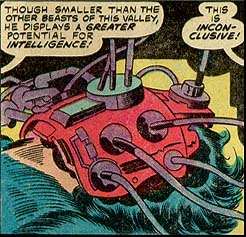
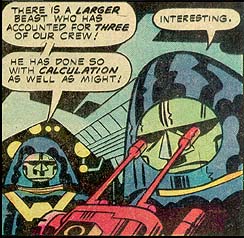
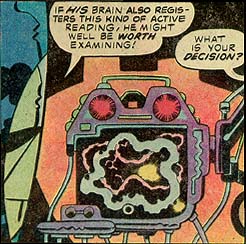
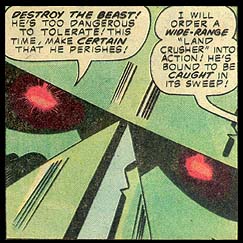
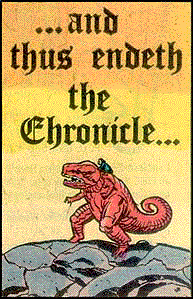 It's
not known how soon in advance Kirby was warned of DEVIL DINOSAUR's cancellation,
so how much of this was real editorial comment by Kirby on the state
of Marvel is also unknown. In the long run it doesn't really matter.
It's
not known how soon in advance Kirby was warned of DEVIL DINOSAUR's cancellation,
so how much of this was real editorial comment by Kirby on the state
of Marvel is also unknown. In the long run it doesn't really matter.